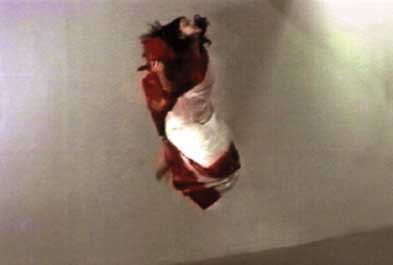
Her Art of Video
Written by Melanie Turpin | Posted by: Anonymous
Jesal Kapadia had no idea when she moved to the United States from India six years ago that she would be the recipient of a much-coveted Artist Grant in the Film and Video category from the Massachusetts Cultural Council (MCC) in 2003. This is not because of any doubts in her abilities or ambition, but because she was already a successful graphic designer. Now an editorial board member of a major academic journal and the author of numerous video installations exhibited at MIT, the Boston Cyberarts Festival, UMass Amherst’s Augusta Savage Gallery, and the Whitney Museum of American Art in New York City, she is firmly ensconced in both the academic and media arts communities.
Winning an MCC grant in the current economic climate is no small feat: drastic state budget cuts to arts organizations around the country have resulted in fierce competition for grants and shrinking recipient lists. Only 31 out of 835 applicants received funds — that’s less than four percent. Though Kapadia’s intriguing and original video pieces stand firmly on their own, the MCC grant further attests to this artist’s remarkable talent and perseverance.
MT: I read that you studied Commercial Arts and Graphic Design in India. Are you from India? Where did you study?
Kapadia: I was born and raised in Mumbai, India, where I studied commercial arts at Sophia Polytechnic. I worked in a couple of advertising agencies in Mumbai (then known as Bombay) as a graphic designer, before moving to the United States. I moved here with the intention of doing my masters in graphic design, but I decided to explore other areas of art making during my stay in Amherst. I loved so much the courses I took as a part-time student, in avant-garde film and visual arts — subjects that I did not have access to in my school in Mumbai — that I took on the opportunity to do my MFA degree in Digital and Video Arts at The University of Massachusetts at Amherst (UMass Amherst). I now spend my time between Brooklyn, NY and Amherst, MA.
MT: What was your education like at UMass Amherst?
Kapadia: Studying at UMass Amherst was fantastic, since I could take classes in the other four colleges as well. My interest quickly shifted from graphic design to animation and video, after taking a couple of courses with some incredible faculty in the five-college area. I studied digital photo, traditional and computer animation, analog and digital video — all as tools to experiment with non-linear narratives.
Theory was essential for my growth as an artist, through which a lot of my interest in post-colonial studies as well as globalization studies comes from. UMass Amherst has a robust economics department, where the journal "Rethinking Marxism" was started 15 years ago. I had the unique opportunity to attend several editorial board meetings held periodically in Amherst, where I was exposed to a lot of stimulating work coming out of their discussions. With the encouragement of my advisor and friend Susan Jahoda, the art editor of the journal, as well as the professor of photography at UMass Amherst, I am now a member of the editorial board. Being part of the UMass Art department and the journal "Rethinking Marxism" has been an extremely enriching experience for me, and has informed a lot of my past and recent work.
MT: Your video project "The Space Between" seems like an intensely personal work; it conveys a sense of uncertainty, and of being lost and at the same time exhilarated, because the subject is suspended in the air, her feet never touching the ground. Are the images meant to represent a state of mind, a self-portrait, or something else?
Kapadia: "The Space Between" is a larger two-channel installation, and the image you mention of the "woman flying" was just one part of it. The person in this animated video is a South Asian student I met at UMass, who agreed to participate in the project I proposed to her. Drawing from the notion of "personal is political," I translated her experience of living as a second-generation Indian in the United States, through a series of still images I captured of her jumping in mid-air. I wanted to map out the liminal space of the body that was living in between two very different cultures, experiencing dual alliances and patriotisms, and thereby engaging in discourses of gender and body politics, immigration and globalization.
MT: Do you have a second job or do you work in video full time?
Kapadia: I also do graphic and web design for various projects, both commercially as a freelancer as well as in my own work.
MT: How did you get involved in MIT’s Media Test Wall program and did you feel your piece fit in well with Ingeborg Lüscher’s, Risk Hazekamp’s, and Euan Macdonald’s and with the "competition" theme?
Kapadia: The series "Competitive Edges" was curated by Jane Farver, the director of List Visual Arts Center, who happened to have come to UMass as a guest speaker. She picked the piece "Flying Woman" for that series. I think all the videos in that screening were complimentary to each other and had a variety of themes emerging, one of them being globalization and body-politics.
MT: What have you been working on lately?
Kapadia: I recently finished a year-long residency at the Whitney Museum — an independent study studio program based in New York. Most of my projects are video works, digitally produced and are non-linear in narration. One of the videos is called "Love Songs," a homage to three everyday objects used in the Indian kitchen.
MT: You participated in "Globalize This! Bridges and Borders Facing Women" with a lecture entitled "India, A Country Without Borders: Art in a Global Culture." Do you suggest that Indian art is or should be far-reaching in today’s globalized world?
Kapadia: There is Indian art that is made by artists living and working in India, and there is art made by the Indian diaspora — which spans almost all the continents today. Both art communities are seriously engaged in making work that is formally, visually and theoretically challenging. It is important to distinguish one community from the other, though, since they both address very different audiences and their art is made under quite specific modes of production and economies, geographical opportunities and reception.
For example, works of United Kingdom-based Indian artist Anish Kapoor, who uses particular Indian materials in his sculptural installations, address a completely different set of formal issues from the artist Zarina Bhimji, who talks about political conditions impacting and uprooting lives of Indians in East Africa in her video installations, or the work of painter Rekha Rodwittya, who is based in Baroda, India, and who engages the viewer with issues of gender politics and womens’ labour in the contemporary Indian society.
In my talk, I discussed the historical and post-colonial contexts of the contemporary Indian artist, whether based in India or abroad, who is constantly challenged by the question "what does it mean to be post-colonial and modernized within the larger traditional Indian culture, and what constitutes a progressive and robust art practice, whether heavily impacted by western norms of production and reception or the local and alternate experiences of modernity and technological enhances?"
MT: What courses do you teach as an instructor at UMass?
Kapadia: I co-taught a theory course there called "Visual Culture: Theory and practice" with Susan Jahoda, and have taught graphic design and animation courses, both as a teaching assistant and as a part-time instructor during the winter session. I don’t teach there anymore, though I will be teaching at City University of New York, Staten Island, in Fall 2003.
MT: Do you strike a balance between the academic study of media arts and artistic endeavor, or do you lean more toward one or the other?
Kapadia: It has always been a challenge to balance the two for me — I am constantly seduced by technology and what it can do, but ultimately it’s a question of choosing the right amount of learning new tools that will make my art-making process easier and more stimulating.
MT: What project or projects are you working on currently?
Kapadia: I recently finished a new video called "The Laughing Club" which will be part of a group show in November 2003 called Global Priority, held at the Herter art gallery in UMass Amherst. This exhibition is part of a larger conference held by "Rethinking Marxism" at the university. I am also working on an outdoor sculpture to be installed in the Socrates Sculpture Park, Queens NY, in August 2003.
More information about Jesal Kapadia's 'The Laughing Club' and Global Priority can be found online at www.marxandtheworldstage.org. To see all the winners of this year’s MCC grants, visit http://www.massculturalcouncil.org/programs/gallery/index.html. For more information on 'The Space Between,' visit http://www.digitalid.8m.net/jesal.html.









